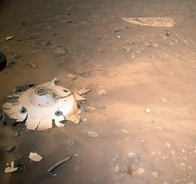There are countless discoveries still to be made in the vastness of space, but sometimes, these scientific revelations are being made closer to home than you'd think.
Even with the amount of effort that has gone into studying and exploring Mars in recent decades, there are still some stunning things being captured remotely, including this strange new image of the planet's sand.
Captured in January 2018, this photograph shows what appears to be a blue sand dune from the surface of Mars. NASA released the photo to their website for the public to see, explaining that the enhanced-colour image was taken by the Mars Reconnaisance Orbiter (MRO).
This photograph was taken in the Lyot Crater of the red planet, a large crater that is known for its patterned ground. The dune is actually closer to grey in terms of its colour, but it's given a blue hue due to a visual effect. The contrast has been upped by the MRO, in an attempt to give researchers more detail when studying the surface of Mars.

In their website post, NASA commented:
"Sand dunes often accumulate in the floors of craters. In this region of Lyot Crater, NASA's Mars Reconnaissance Orbiter (MRO) shows a field of classic barchan dunes on Jan. 24, 2018.
"Just to the south of the group of barchan dunes is one large dune with a more complex structure. This particular dune, appearing like turquoise blue in enhanced color, is made of finer material and/or has a different composition than the surrounding."
It's good to know that there are still wonders for us to capture out in space, even in our own solar system.

